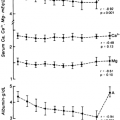ORTHOSTATIC HYPOTENSION
Orthostatic hypotension is defined as a critical and symptomatic reduction in blood pressure on the assumption of upright posture. It is caused by the failure of normal blood pressure homeo-stasis, and it reflects the loss of vasoconstrictor reflexes in both resistance and capacitance vessels. This loss is attributable to defects in either peripheral (postganglionic) neurons or central (preganglionic) neurons.71 The first category, which is the largest, includes many diseases with associated peripheral neuropathies, such as diabetes mellitus, tabes dorsalis, alcoholism, amyloido-sis, and the Holmes-Adie syndrome (unilateral, enlarged pupil, an absent or delayed response to light, a slow reaction on convergence, and a good response to miotics or mydriatics). In these diseases, the orthostatic hypotension is usually accompanied by dysfunctions in potency, sweating, and sphincter control.
A consensus statement has established the following categories of primary autonomic insufficiencies or dysautonomias: (a) pure autonomic failure that occurs without other neurologic features, (b) Parkinson’s disease with autonomic failure, and (c) multiple system atrophy, a sporadic, progressive disorder of adults characterized by autonomic dysfunction, parkinsonism, and ataxia in any combination. The latter category is divided into three types: (a) striatonigral degeneration when parkinsonism predominates, (b) olivopontocerebellar atrophy when cerebellar features predominate, and (c) Shy-Drager syndrome when autonomic failure predominates.71 Further differentiation of these disorders has been made on the basis of neurochemical analyses and positron emission tomography using 6-[18F]fluorodopamine.72 A classification of dysautonomias has been proposed72 in which sympathetic neurocirculatory failure results from peripheral sympathetic denervation or decreased or absent sympathoneural traffic, with or without signs of central neural degeneration, and in which both parkinsonism with sympathetic neurocirculatory failure and multiple system atrophy
without sympathetic neurocirculatory failure differ from the Shy-Drager syndrome. Patients with the Shy-Drager syndrome have poor or no response to therapy with levodopa-carbidopa, intact cardiac sympathetic innervation, and a poor prognosis, whereas patients with parkinsonism, postural hypotension, and cardiac sympathetic denervation have a better prognosis.72
without sympathetic neurocirculatory failure differ from the Shy-Drager syndrome. Patients with the Shy-Drager syndrome have poor or no response to therapy with levodopa-carbidopa, intact cardiac sympathetic innervation, and a poor prognosis, whereas patients with parkinsonism, postural hypotension, and cardiac sympathetic denervation have a better prognosis.72
Stay updated, free articles. Join our Telegram channel

Full access? Get Clinical Tree






